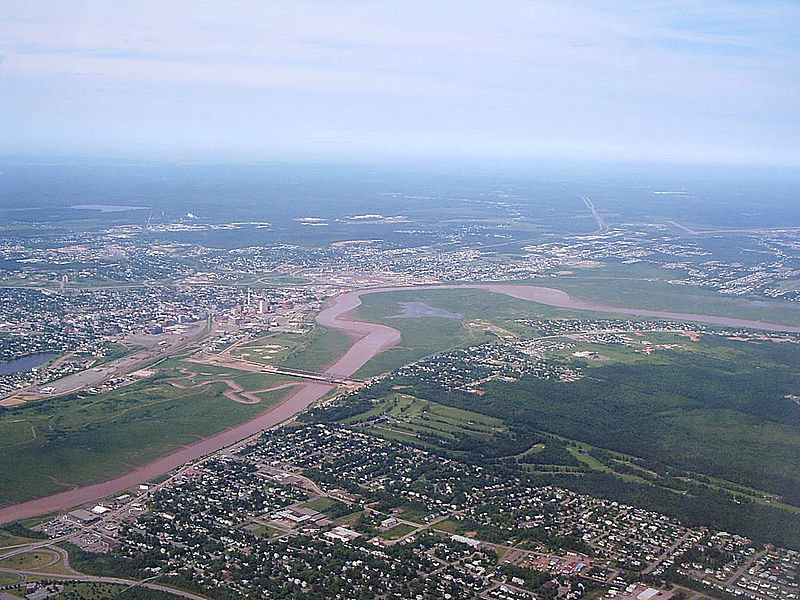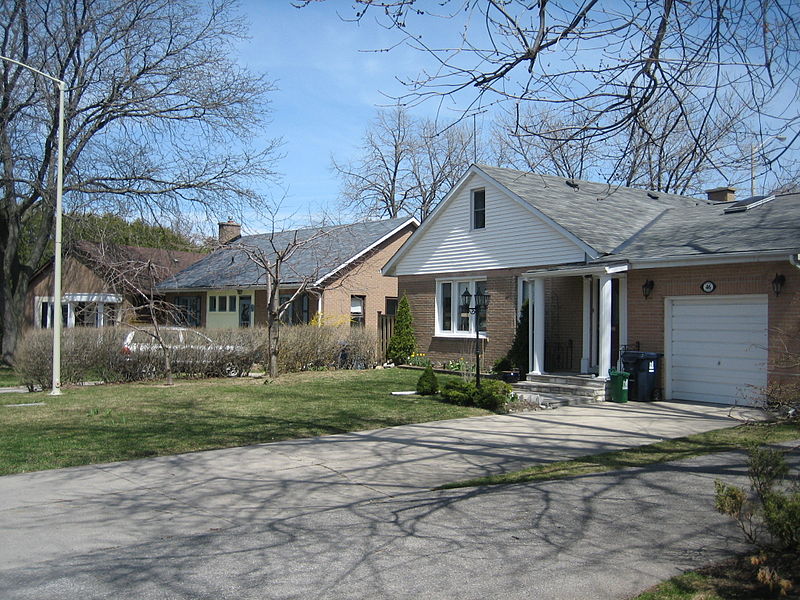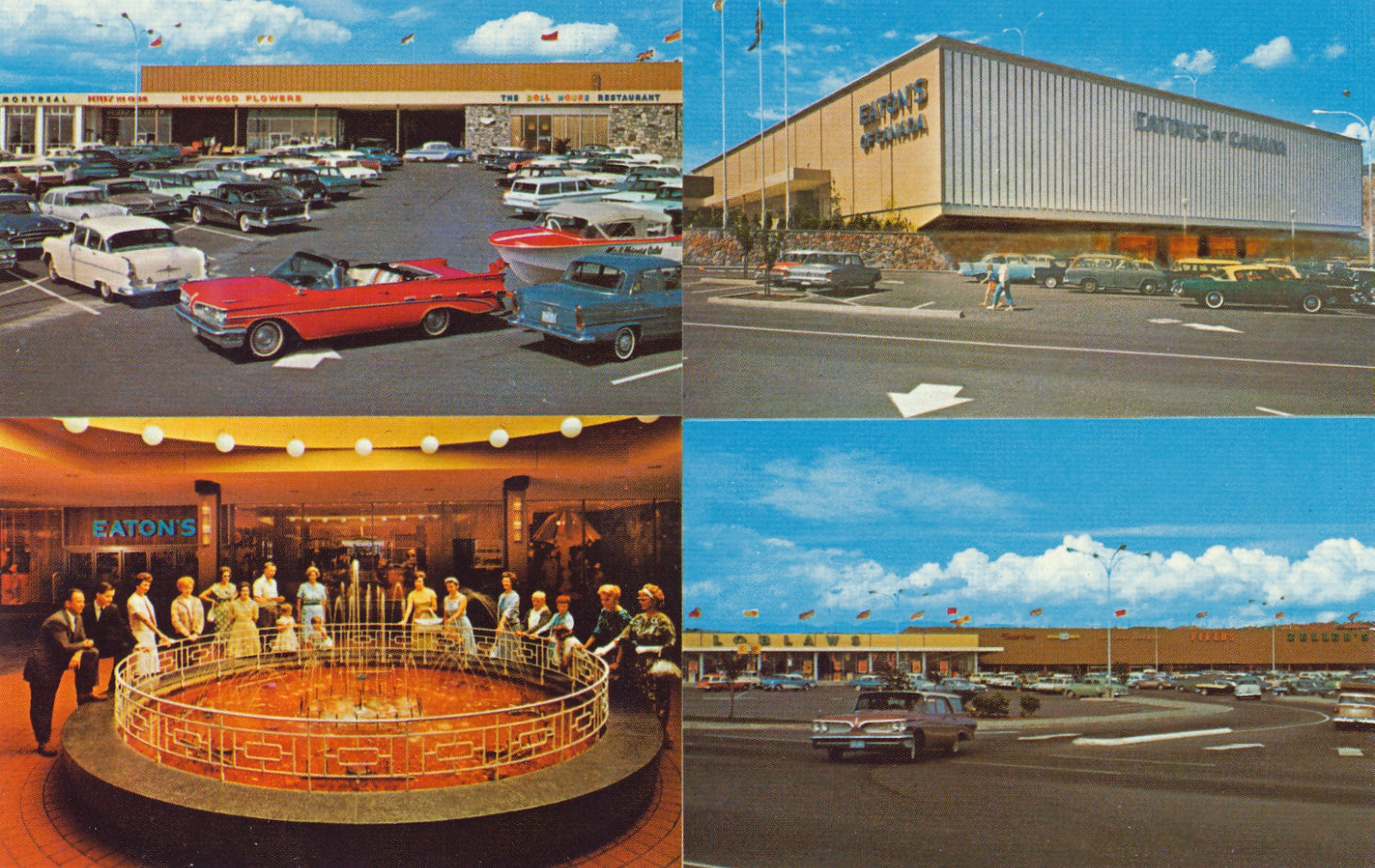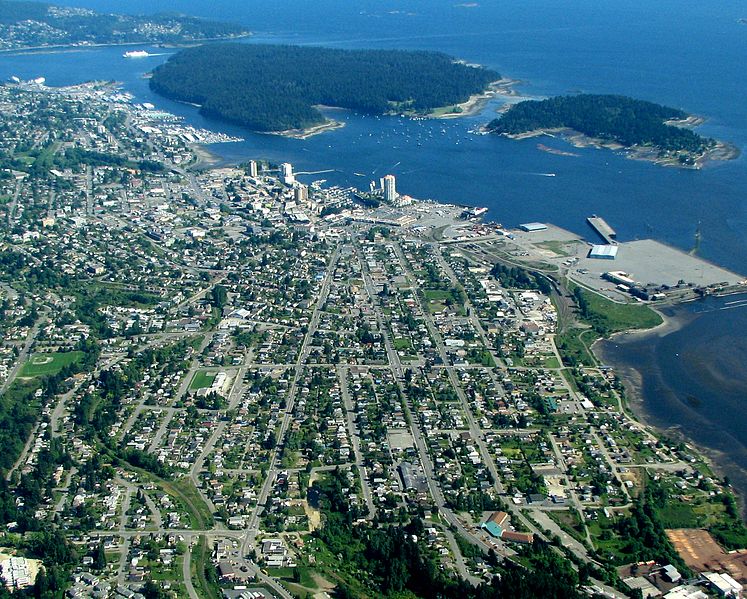Chapter 9. Cold War Canada, 1945-1991
9.13 Cold War Society: Cities and Suburbs

At the turn of this century, only one city in the Atlantic provinces surpassed the 100,000 mark in population. Halifax stood as the 14th-largest urban area in the country, with 359,111 people in 2001. St. John’s (in 20th place) had a population of 99,182, and all of the rest were below 70,000. The combined populations of Saint John, Moncton, Fredericton, and Charlottetown were hardly more than that of Saskatoon, and if St. John’s and Corner Brook were added, they still wouldn’t be a match for Halifax.
Because large urban areas make more media noise than smaller centres, because media and capital are centralized in the biggest metropolises, and because the influence of the top three or four major cities is so pervasive, it is easy to lose sight of the rather more modest urban experiences of some Canadian regions in what many commentators called the “century of the city.” Rare, however, is the city of any size that has not been impacted by many of the urban trends that define modern life, of which automobilism, suburbanization, the baby boom, multiculturalism, and commercialization of space are only a few examples.

An Urban Country
The size of Canada — which includes many imperfectly mapped islands in the Arctic — inevitably produces shockingly low population density levels. At 3.4 per square kilometer in 2015, Canada ranks slightly ahead of Iceland and Australia among developed economies but behind the rest. And yet, the majority of Canadians live in urban centres and have since 1921. In that year, 1.65 million people lived in cities with a population of 100,000 or more (of which there were only six), out of a total national population of 8.8 million; in 1941, 2.6 million out of 11.5 million were living in that largest tier of cities (of which there were now eight); and, in 1961, 4.2 million out of 18.2 million were big city dwellers. In 1976, nearly half of the 23 million Canadians were living in 100,000+ sized cities. By contrast, the percentage of Canadians living in cities of 5,000 or fewer has fallen from 19% in 1921 to 15% in 1951 and 11% in 1971. Small-town life has become more uncommon in part because small towns became large towns and large towns became small cities, but it is clear that the social dynamics that defined the lives of Canadians before 1921 changed dramatically in the 20th century.

Suburbia
Much of that growth was taking place not in the actual cities but in their neighbouring municipalities. It is worth noting that there have been several resource extraction towns founded in the last 100 years but no new cities. The late 19th century saw the birth of every major city in western Canada (apart from slightly older Victoria and New Westminster), but the only truly new centres in the 20th century are satellites and suburbs of the largest metropolises. Mississauga, Brampton, Surrey, Laval, Markham, Vaughan, and Burnaby are examples drawn from the largest 20 cities in Canada, none of which contained more than a few thousand in 1914, all of which are very near or past the quarter-million mark now. Each of these began as peripheral, spillover, bedroom communities associated with a larger urban centre and, in that respect, they were very typical.[1]
The setting for modernity was urban, but the lives of most Canadians in the 20th century increasingly became defined as something different: suburban.
Beginning in the 1920s, Canadians began a migration away from city centres to the margin. Initially, what was considered “suburban” was merely the outskirts of the original city. Suburbanization faltered in the 1930s and early 1940s and then resumed in earnest in the postwar period. At that time, larger and larger numbers of city dwellers evacuated old neighbourhoods for entirely new communities.
Suburbanization was driven by several push factors. Housing stock in the city centre had grown overcrowded due to the poverty of the 1930s (as mortgage payments were missed and the number of rental units increased) and with the arrival of large numbers of ex-soldiers after the war. Large older homes were converted to rooming houses with less privacy and aging plumbing, heating, and wiring. In Vancouver, the second Hotel Vancouver was turned into veterans’ housing, so pressing was the demand for accommodations. As well, the city centres and older neighbourhoods were increasingly associated (rightly or wrongly) with crime, violence, and — from the perspective of Anglo-Celtic and Francophone Canadians — the presence of new immigrants and unfamiliar visible minorities. Finally, the baby boom (considered below) was underway and the need for more spacious houses was widely felt.

The pulls of suburbia were also numerous. Some industries were relocating to the edges of cities, and population followed. Housing prices were lower and so were property taxes. Suburban housing typically contained significantly more floor space than was available in houses in older blue-collar areas. Suburban lots — as large as 50 foot (15.24 metres) wide — compared very favourably to the 25 or 33 foot (7.62-10 metre) lot commonly found in the centre of western Canadian cities. Neighbours were, therefore, not cheek-by-jowl with one another. As suburban infrastructure grew there were highways that connected outlying areas with urban industrial nodes and the city centre. There were also new schools that were instantly a step up from the deteriorating facilities in the inner cities. Young postwar baby-boom families were attracted by all of these features.
Working — without much effect — against these pulls, were several drawbacks to suburban life. Urban families tended to stick to identifiable neighbourhoods before 1945 — generally, spaces that were associated with ethnicity, church, and sources of preferred types of food. In the suburbanization process, siblings did not (or could not) necessarily buy in the same areas, which meant that the supports formerly on offer between family members were more tenuous.
Culturally, suburbs were thought to be deficient. Civic amenities might include parks, rinks, and pools, but it was rare in the period from 1945 to 1970 to find art galleries or performance spaces outside of the old city cores. Zoning that forbade commercial properties from residential areas meant that there was no corner shop to turn to for small, immediate necessities; bottles of milk and loaves of bread were often delivered door-to-door, but if a pint of cream was needed mid-week that meant a trip in the car to the nearest shopping plaza. Pedestrianism was discouraged by distances and by the sprawling parking lots in shopping strips. As shopping malls appeared for the first time in the 1950s there began a process of concentrating retail space in nodes (with “plenty of free parking”) rather than along “high streets,” a fact that contributed further to the rise of automobile dependency. Most households therefore had to have two cars at their disposal. This luxury carried with it higher energy and individualized maintenance costs, and a concomitant rise in demand for more road capacity and parking. There was as a result more air pollution and alienation from the very greenspace that once made the “leafy suburbs” attractive. In lieu of a natural town or village centre in most suburbs, the shopping mall emerged as the de facto focal point for social interaction. Consumerism was thus encouraged by the lack of other possible sites of community contact.

Return to Civvy Street
Readjustment to peacetime in 1945 was welcomed by a generation that had lived through economic disaster and global conflict. It was also approached with some trepidation. The immediate postwar era a generation earlier had brought unemployment, a pandemic, and labour unrest. Some of these concerns were addressed at the political level (see Section 8.12). No initiative was as comprehensive in this respect as the 1944 Veterans Charter.
At war’s end, there were some 900,000 men and women who had served in some capacity. The Charter provided $1.2 billion to facilitate their reintegration. This included a one-time pay-out, cash for civilian clothing, and life insurance. Funding was available for post-secondary education at university or in vocational schools. The Central Mortgage and Housing Corporation (CMHC) was created in 1946 to assist Canadians with their first home purchase and the renovation of older homes (neglected during the Depression and not helped by material shortages during the war).[2] Oversight for these and other projects was provided by the newly-established Department of Veterans’ Affairs (later renamed Veterans Affairs Canada).
Legislative and social pressures combined to enable returned soldiers to reclaim their old jobs (if, indeed, they had been formerly employed). This meant, inevitably, removing women from the industrial workforce. For returning servicewomen, however, no similar commitment was made. The end effect was to make marriage and housewifery the default career path for women who were not nurses, secretaries, or teachers.
Would suburbanization have occurred with such rapidity in the postwar years had it not been for this context? It is unlikely. CMHC brought homeownership within reach of a generation that had, less than a decade earlier, experienced record-setting levels of unemployment, cash shortages, and falling wages. The economic boost provided by the war had one other related impact that drove forward suburban growth.
The Baby Boom
As economic conditions began to improve slightly in the late 1930s, so too did the nuptiality (marriage) rate and the number of births. The earliest hint of a fertility recovery, however, was nothing compared to what would come after World War II. In 1911, there were 4.8 million Canadians over the age of 15 years, of whom 2.6 million were married; that share — about half — survived until the 1950s, when it reached two-thirds and then crept up to three-quarters in the early 1960s. In the post-war, Cold War years, being married, building a family, and — yes, being born — was the experience of a growing number of Canadians.
The declaration of war in 1939 was followed by a veritable stampede to the wedding altar. In Vancouver, for example, there was a 26.6% increase in the number of marriages registered over the previous year. To give this more perspective, it represents a doubling over the 1933 incidence of nuptiality in the city. Births would follow soon thereafter.
Nationally the number of births in 1937 was only 227,900 and then it shot up to pre-Depression rates in 1940, surpassing every year in the 1920s other than 1921, at 263,993. The crude birth rate rose from 20.1 in 1937 to 24.3 in 1945 and kept going up until it peaked in 1947 at 28.9. It then sagged a bit and then recovered in 1954 to 1957, when it hovered just above 28 per 1000. There were twice as many live births in 1956 (450,700) than there had been in any year in the 1930s. What is more, although the share of births that were illegitimate climbed during the war years from 3.9 to 4.5% of the total number of births, illegitimacy declined to a mid-1950s trough of about 3.8%.
More and more births took place in hospitals. In the 1920s, the share of hospital births was around 1 in 4; in the 1930s, it climbed to about 1 in 3, passing the 40% mark in 1939; by the end of the war, the figure was nearly 64%; by 1960, it was nearly 95%; and from 1965, it was 99%. Whatever the risks entailed in hospital births, the neo-natal and infant mortality rate fell from 81 per 1000 live population in 1931 to 1935 to 26 in 1960-1965, a remarkable achievement in public health. Likewise, stillbirths fell from nearly 32 per 1000 live births in 1931 to fewer than 12 in 1965.[3]
The enormity of immigration in 20th-century Canada (considered in Section 5.11) has tended to overshadow another important demographic behaviour: migration. As with the arrival of newcomers, the movement of Canadians from one province to another has had a westward bias. The other provinces and the Territories are more fully represented in British Columbia and Alberta than in any of the Maritime provinces, and this has been the case since the early 20th century. It is difficult to track interprovincial movement but we can identify out-migration patterns. From 1921 to 1961, there was only one decade in which Nova Scotia saw fewer people leave than arrived; in the same period PEI and New Brunswick (and, after 1949, Newfoundland) experienced substantial and sustained net out-migration. The decade in which this softens — the 1930s — offered up such poor economic prospects in the rest of the country that Maritimers were less likely to head “down the road.” Which suggests, of course, that interprovincial pulls are at least as important as pushes. The West was not exempt from abandonment: Manitoba was a net loser of population from 1921 and Saskatchewan from 1931. Alberta experienced net migration from 1931 to the 1950s. In fact, only British Columbia and Ontario registered net increases in migration across every decade of the 20th century.[4] Moving to where the jobs are became a powerful tradition in its own right in Atlantic Canada in the mid-20th century.
White Flight
The ability to move to suburbia seemed, at the time, a very democratic one. But, in fact, it was one enjoyed mostly by Canadians who held steady jobs, and most of those people were drawn from the British and French context populations. New immigrants continued to pour into the old urban centres and their numbers were growing as the postwar migrations gathered speed (see Section 5.11). West Indian, South Asian, and other visible minorities took over spaces vacated by those who made their way to the suburbs. Growing diversity in urban cores contributed to still more movement to the suburbs by more established Canadian households in what has been called white flight.
The effect on city centres of this evacuation is important to note. Downtowns in the first half of the 20th century had been a focal point for entertainment and commerce; by the 1960s, many were gutted. Live theatre and music venues closed down, old movie palaces became dilapidated and doomed for demolition, neighbourhoods that were increasingly viewed as irredeemable slums were ploughed under to make way for freeways that would conduct suburbanites to and from work. Downtown department stores retained some customer loyalty, but the spread of suburban shopping malls were a blow from which they would never fully recover. The impact of this abandonment of the city centres can still be seen in many Canadian metropolises. Some, like Winnipeg, are a patchwork of vacant lots and are very unpopulated after dark. The leading cities, however, turned the availability of land in what was now called the Central Business District (CBD) to advantage by erecting the country’s second generation of skyscrapers. Built of steel, concrete, and glass, these mostly corporate-owned or chartered bank-owned towers sprang up first in Montreal (the country’s financial capital at the time and the largest city) and were as much as twice the height of pre-WWII towers. The skylines of the largest downtowns across the country followed suit and began to reflect a pattern of trademark styles. The black glass Toronto-Dominion towers were instantly distinguishable from the white-edged Bank of Montreal skyscrapers. Montreal also led the way in suburban sprawl, so much so that by 1996, 75% of Montrealers actually lived outside of the city proper.
Toronto’s leadership responded to the changes associated with population and spatial expansion in 1953 by creating a federated Municipality of Metropolitan Toronto. Known as Metro, the new administrative body took in the City of Toronto and the suburban municipalities of Etobicoke, York, North York, East York, and Scarborough. This new organism accomplished much but some of its projects were highly controversial.

As the flight to the suburbs accelerated in the 1950s and pressures grew to develop more and better highway systems, a generation of planners appeared whose approach to depressed areas was to bring in the bulldozers. Some took their lead from American cities where variegated downtowns were gutted to make way for sleek, high-density social housing projects and cloverleaf overpasses. Largely because the Canadian economy and population lagged somewhat behind the Americans, some cities were spared the worst excesses of this period. Even in the United States, however, the wisdom of obliterating whole communities in the name of faster traffic flow and rationalized modern housing was being questioned.
At the forefront of the debate was New York’s Jane Jacobs (1916-2006). In the mid-1950s, Jacobs began a public critique of slum clearance and urban renewal in Manhattan. Jacobs’ successful crusade was noted in the Canadian media. When she emigrated to Canada in 1968 (in part to keep her draft-age sons out of the Vietnam War), she became a high-profile lightning rod for Torontonians angered at the proposed Spadina Expressway. The battle to stop the project was ultimately successful. As Ontario Premier William (Bill) Davis (b. 1929) observed in 1971:
If we are building a transportation system to serve the automobile, the Spadina Expressway would be a good place to start. But if we are building a transportation system to serve people, the Spadina Expressway is a good place to stop.[5]
The collapse of the Spadina Expressway project in Toronto coincided with the death of radical proposals for slum clearance. The Bonaventure Expressway took a bite out of Griffintown in Montreal and the Autoroute Ville-Marie displaced hundreds. The construction of waterfront expressways and viaducts through Vancouver’s East End, Gastown, Chinatown, and Strathcona were stayed. These were unusual survivors, in that neighbourhoods containing ethnic minorities and Aboriginal peoples generally did not fare well in the battle with bulldozers and highways. An African-Canadian neighbourhood in Vancouver and Winnipeg’s Rooster Town, a Métis community, were both cleared to make way for, respectively, a viaduct and a suburban school.[6] Clearances of these neighbourhoods, along with the wide variety of shantytowns that existed on civic peripheries (in defiance of modern norms of property ownership and conceptions of public health), were a way to rationalize cities, to colonize neighbourhoods and pastureland alike with a modern vision of Canadian life.
Suburbanization gave the Canadians who could afford it the space they deeply wanted and a sense of building new communities that echoed the “pioneer” experience. There were significant liabilities to this trend, including the isolation of housewives on the periphery, the loss of access to cultural facilities, and huge environmental consequences. Publicly owned transportation systems such as streetcars were pulled out of service to create more room for privately owned automobiles. Less obvious is the extent to which private space became dominant, superseding public space. The gathering in a town square, the crowded meeting at city hall, the spontaneous spilling of crowds off a sidewalk onto the street to watch a parade or to engage in protest: these did not disappear entirely but were much less common than they had been in the pre-WWII years. The authorities could point to this change with some satisfaction because it meant that another general strike like Winnipeg’s in 1919 was unlikely. The possibility of rioting unemployed workers was likewise diminished. The trade-off was several generations that retreated into their living rooms and recreation rooms to engage with the civitas only through a television screen.
What came out of suburbia was a population and culture unlike any before it. More highly educated and with expectations of continued prosperity, the baby boomers challenged the state to keep up with demands for services, institutions, and opportunities. As a voting population, they have been a decisive force since they first started voting in the 1960s. This was the first generation raised on television and nurtured by consumerism, a generation for which car-ownership and home-ownership was a given, if not a right. By the 1970s, more of Canada’s housing stock had been built since 1945 than before, and the vast majority of that construction took place in suburban tracts. The suburbs were the cradle of what would rapidly emerge as the majority of Canadians, and gradually it became the case that these were more diverse neighbourhoods than the enclaves left behind in the old city centres.
Discounted by planners and often ridiculed (sometimes rightly) for their alleged soullessness, no exploration of contemporary Canadian culture and values would be complete without a serious understanding of the legacy of suburbanization.
Key Points
- The 20th century saw the number of large cities increase, the share of population living in large cities rise and the experience of growing up or residing in small towns retreat.
- Most urban growth in the second half of the 20th century took place in suburban neighbourhoods. Suburbs were attractive for economic reasons and because the housing stock and schools were new, automobilism made them (and workplaces) accessible, and shopping malls made them self-sufficient.
- Suburban life was made possible by social policies like the Veterans Charter and the CMHC.
- The end of the Depression, the start of WWII, and demobilization all contributed to the baby boom which, in turn, contributed to suburbanization.
- Abandonment of city centres led to the collapse of downtown commerce and its replacement with financial districts. It also led to massive highway projects that would obliterate older — often ethnic — neighbourhoods.
- Reactions against highways projects would rescue some Canadian centres from being paved over and would generate a renewed interest on creating livable spaces in the cities.
- Suburbia emerged as the new cradle of Canadian society and culture — a place with a gendered geography and a tendency to favour private space over public.
Media Attributions
- Whitehorse, Yukon Panorama, 2008 © C. Robson is licensed under a CC BY-SA (Attribution ShareAlike) license
- Moncton, “Le Coude”, vue aérienne © Sebastien Paquet is licensed under a CC BY (Attribution) license
- Surrey Aerial View is licensed under a CC BY-SA (Attribution ShareAlike) license
- Don Mills Homes © Simon Pulsifer is licensed under a CC BY-SA (Attribution ShareAlike) license
- Postcard: Brentwood Shopping Centre, Burnaby, BC, 1963 © Rolly Ford, Natural Color Productions is licensed under a Public Domain license
- Nanaimo Aerial View © Wikipedia user KenWalker is licensed under a CC BY-SA (Attribution ShareAlike) license
- Richard Harris, Creeping Conformity: How Canada Became Suburban, 1900-1960 (Toronto: University of Toronto Press, 2004). ↵
- Jill Wade, Houses for All: The Struggle for Social Housing, 1919-1950 (Vancouver: University of British Columbia Press, 1994). ↵
- Statistics Canada, Historical Statistics of Canada, 2nd edition., F.H. Leacy, ed. (Ottawa: Statistics Canada, 1983): B1-14, B23-50. ↵
- Warren E. Kalbach and Wayne W. McVey, The Demographic Bases of Canadian Society (Toronto: McGraw-Hill, 1971), 86. ↵
- John Sewell, The Shape of the City: Toronto Struggles with Modern Planning (Toronto, Ontario: University of Toronto Press, 1993). ↵
- David G. Burley, “Rooster Town: Winnipeg’s Lost Métis Suburb, 1900-1960,” Urban History Review, XLII, no.1 (Fall 2013): 3-25. ↵
Suburbs to which commuters return at the end of the day to do little other than sleep before commuting out to jobs elsewhere; applies especially to those suburbs that are largely free of industry and other sources of employment.
The low density housing districts beyond the city limits; the expansion of cities beyond their boundaries into bordering municipalities, creating low density and car-dependent districts with few amenities other than housing.
Introduced in 1944; provided funds to enable the transition to civilian life of Canadian troops; included free university education, payment for time served, life insurance, and money for civilian clothes. The Charter also guaranteed that ex-servicemen and women could reclaim their former jobs, which had the effect of displacing women who had worked in industry during wartime.
Created under the National Housing Act, 1944; enabled low income families (including demobilized servicemen and women) to obtain low cost mortgages; created social housing; funded construction of new rental housing; and continues to function in 2016.
The number of births occurring in a community or nation per 1,000 population.
In legal and demographic terms, a child born to unmarried parents (or "out of wedlock").
Colloquial term for the migration of middle and working class European-Canadians from declining and multi-ethnic city centres for the suburbs; associated earlier in the United States with racial tensions in cities and more homogeneously Euro-American suburbs.
The concentration of commercial, business, and finance enterprises generally in the centre or downtown of most cities. Some cities, like Toronto, have several such hubs.
The low density housing districts beyond the city limits; the expansion of cities beyond their boundaries into bordering municipalities, creating low density and car-dependent districts with few amenities other than housing.
The federated Municipality of Metropolitan Toronto.
A married woman whose principle (unpaid) occupation is the maintaining of her household, including preparing food, cleaning clothes, providing pre-school education, and cleaning house.

